Aquatic mobile assembly instructions
Congratulations on your purchase of the new A2X501b origami mobile assembly kit! With just a few simple steps, you'll have a beautiful mobile which brings beauty, happiness, world peace and toaster ovens into every home!
First, a summary of the package contents:

- Three lillypads
- Three balancing sticks
- Three loops of brown string
- One triangular mobile base
- Six fish hooks
- Six fish
- Three fish hanging lines
- Two wall mounting hooks
- Spare parts:
- An extra balancing stick
- Spare leather ribbon
- Extra hooks for each format used
- Spare thread and paperclip
Step 1: Hanging the mobile base
Start by deciding where you want the mobile to hang. The final height between bottom of the mobile and the hook it hangs from will be aproximately two feet. The diameter of the mobile is slightly less than two feet. We do not recommend hanging the mobile directly over a baby's crib or within reach of young children as the mobile contains free-hanging items which could fall off in a strong wind, earthquake, or earth-shattering cataclysm. Once the spot has been chosen you can use either of the wall mounting hooks (item 8) provided or a hanging device of your choice. After a hook has been securely placed, hang the triangular mobile base (item 4) on that hook using the small metal loop at the top of the leather strings.
Step 2: Threading the lillypads
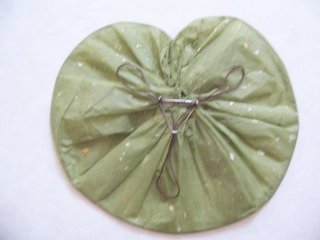 Looking at the top of each lillypad (item 1), you will see a small metal triangle
with a metal loop protruding from each corner. This is the point from which
the lillypad will hang. Start by taking one of the loops of brown string (item 3)
and bending it into a "Y" shaped loop. Then take each arm of that loop and thread
it through a corresponding metal loop on the lillypad. Repeat this on the other two
lillypads.
Looking at the top of each lillypad (item 1), you will see a small metal triangle
with a metal loop protruding from each corner. This is the point from which
the lillypad will hang. Start by taking one of the loops of brown string (item 3)
and bending it into a "Y" shaped loop. Then take each arm of that loop and thread
it through a corresponding metal loop on the lillypad. Repeat this on the other two
lillypads.
Step 3: Hanging the lillypads
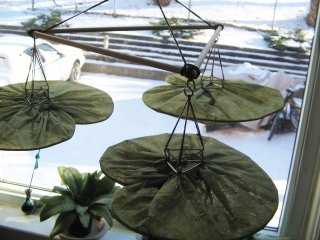
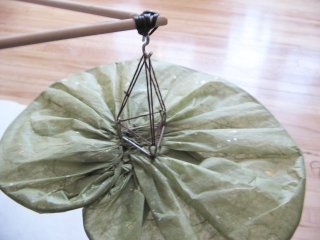
Take each of the three newly formed "arms" of thread, and hold them together so that they all follow a single loop. Then take that loop and hang it on one of the corner hooks on the mobile base. Repeat this with each of the lillypads, each one occupying a corner of the triangle.
Important Note: When hanging the mobile base (step 1), you will see that the base does not hang on the level and that one of the corners dips down further than the other two. This is to account for the fact that the lillypads are not the same weight. It is important to hang the smallest of them from the corner that dips down. You will be able to see very easily if the pads are not hung in the correct order, as there will be a significant difference in height. The angle at which the lillypads hang will require adjustment as well. This can be done easily by simply holding one and rotating it. The string it hangs from will slide and adjust accordingly.
Step 4: Looping the fish-hanging lines
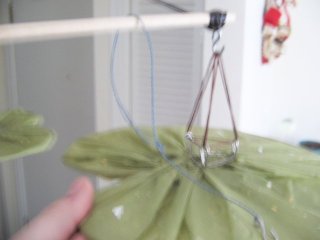 Take one of the fish-hanging lines and hang it over one edge of the mobile
base. Then take the hook end of the line and run it through the loop end of the
line, forming a contracting loop around the triangular base. Pull on the
hook end of the line until the loop closes around the edge of the mobile base.
The line should be aproximately halfway between the corners of the base, and
should hang freely between the two lillypads that hang from those corners.
This needs to be reapeated with the other two fish-hanging lines, on the other
two edges of the base.
Take one of the fish-hanging lines and hang it over one edge of the mobile
base. Then take the hook end of the line and run it through the loop end of the
line, forming a contracting loop around the triangular base. Pull on the
hook end of the line until the loop closes around the edge of the mobile base.
The line should be aproximately halfway between the corners of the base, and
should hang freely between the two lillypads that hang from those corners.
This needs to be reapeated with the other two fish-hanging lines, on the other
two edges of the base.
Step 5: Hanging the balancing sticks
 For each of the balancing sticks, hang it's center loop over one the hooks at
the bottom of each fish-hanging line. The order in which they are hung will not
affect the working of the mobile, and you can place them in whatever order you
prefer. For aesthetic purposes, we would recommend hanging the longest one on
the middle-length fish-hanging line.
For each of the balancing sticks, hang it's center loop over one the hooks at
the bottom of each fish-hanging line. The order in which they are hung will not
affect the working of the mobile, and you can place them in whatever order you
prefer. For aesthetic purposes, we would recommend hanging the longest one on
the middle-length fish-hanging line.
You will notice that the longest of the balancing sticks does not hang level. This happens because one of the fish is made with a heavier paper than the others and must be hung on the higher side of this balancing stick. The heavy fish is the one with a purple body and pink lips, which is shown in the picture on the following step. The other fish are all of the same mass and are 100% interchangable.
Step 6: Hooking the fish
 Looking closely at the fish, you will notice that each one has a small leather loop
on top. This loop is the point from which the fish hangs. With each fish, take
a corresponding fish hook, and slip the larger end of the hook through the loop.
Looking closely at the fish, you will notice that each one has a small leather loop
on top. This loop is the point from which the fish hangs. With each fish, take
a corresponding fish hook, and slip the larger end of the hook through the loop.
Step 7: Hanging the fish
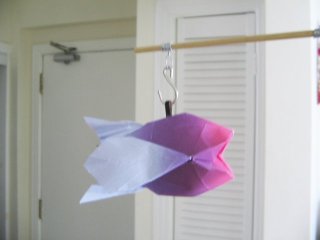 With each fish, take the smaller loop of the fish-hook that's connected to it
and hang it over the thin metal loop at either end of a balancing stick. Once
again, note that the purple fish with pink lips is heavier than the others and
must be hung on higher end of the unbalanced stick.
With each fish, take the smaller loop of the fish-hook that's connected to it
and hang it over the thin metal loop at either end of a balancing stick. Once
again, note that the purple fish with pink lips is heavier than the others and
must be hung on higher end of the unbalanced stick.
The finished mobile
 You have now finished assembling the mobile! You may need to make some final
adjustments to correctly balance all of the mobile's components. The lillypads
may require adjustment to be leveled. Also, the balancing sticks may need to be
adjusted to make the fish hang on the level. This can be done by gently bending
the wire loops at the ends of the sticks, as well as the center loops from which
they hang. Care is required here as excessive bending may break the wire that
forms those loops.
You have now finished assembling the mobile! You may need to make some final
adjustments to correctly balance all of the mobile's components. The lillypads
may require adjustment to be leveled. Also, the balancing sticks may need to be
adjusted to make the fish hang on the level. This can be done by gently bending
the wire loops at the ends of the sticks, as well as the center loops from which
they hang. Care is required here as excessive bending may break the wire that
forms those loops.
You may find that if the longest balancing stick is not hanging on the bottom, the fish that hang from it tend to collide with the strings that hold up the lower sticks. This can be accounted for by sliding those supportive strings (the fish-hanging lines) along the mobile base away from the longest stick. These can only be slid so far as there is a limited amount of space between the lillypads where they hang.
If you have any technical problems or do not find our product is functioning properly, please call our non-toll-free support hotline and one of our technical support representatives will make dirty jokes at you. Hours of operation are between then and now, and a little bit of here and there.